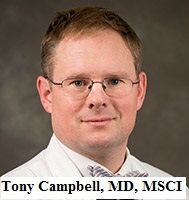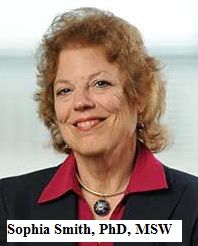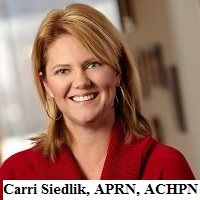- Center on Health Equity & Access
- Clinical
- Health Care Cost
- Health Care Delivery
- Insurance
- Policy
- Technology
- Value-Based Care
Patient and Provider Perspectives on Palliative Care Discussed at NCCN
During the opening session at the National Comprehensive Cancer Network 21st Annual Conference, healthcare providers came together to discuss palliation from the provider and the patient perspective.
During the opening session at the National Comprehensive Cancer Network 21st Annual Conference, in Hollywood, Florida, healthcare providers came together to discuss palliation from the provider and the patient perspective. The session, Palliative Care: Providing Comfort from a Patient and Provider Perspective, was moderated by Toby C. Campbell, MD, MSCI, associate professor and chief of the palliative care program, University of Wisconsin School of Medicine and Public Health. He was joined on the panel by Maria Dans, MD, assistant professor, Department of Medicine, clinical director of Palliative Care Services, Siteman Cancer Center at Barnes-Jewish Hospital and Washington University School of Medicine; Sophia Smith, PhD, MSW, associate professor, Duke Cancer Institute; and Carri Siedlik, APRN, ACHPN, Fred & Pamela Buffett Cancer Center. The panel also had a family member advocate, Shirin Malekpour, PhD, University of Wisconsin-Madison.

“Palliative care has a lot of different aspects,” Campbell said. “We’ll focus today on cutting-age palliative care as we build the infrastructure to meet palliative care needs of cancer patients, and this is much upstream from end-of-life care and hospice.”
Campbell then invited Malekpour to share her experience with her mom.
“My mom was a pediatric hematologist/oncologist in Iran,” said Malekpour. She explained that she was a pathbreaker in her own right, who led the fight for women’s rights to make decisions and gain access to services like birth control. She was diagnosed with stage 3 ovarian cancer and died within 18 months, Malekpour told the audience. “Although my husband was aware of palliative care, being a hematologist himself, and my mom being a doctor, we were so physically and emotionally drained that we did not know the right questions to ask,” Malekpour said. She added that the medical team at the hospital was underprepared for palliative care, and that they were aware of palliative services only because her husband worked at the same hospital.
She narrated an incident that occurred during her mother’s treatment. “One night a fellow came late to the hospital when [my mother] was vulnerable and alone. He got a [do not resuscitate] signature from her. It made us really upset…not that we did not agree with her decision. It was just how it was handled.” She said that was when they ended up getting palliative care, but only because her husband was a part of the team.
Campbell said that all oncologists provide palliative care, explaining that it can be primary palliative care (such as what primary care doctors provide), secondary palliative care (what all oncologists provide), and tertiary palliative care (expert level palliative care). “A section of your patients could be referred to an expert palliative care specialist,” Campbell said.
Duke has been partnering with a company called Reimagine, which educates patients on 4 typical conversations on palliative care. The program provides online content and group-facilitated meetings led by a social worker. Patients can get conveniently get together with their peers, online. The end goal, Smith explained, is to improve the patient’s and their caregiver’s situation, improving communication with providers. Patients are also encouraged to complete their advance directives.
Barriers to Providing Palliative Care
Campbell said that cancer patients hospitalized in their inpatient oncology unit have a relatively short life expectancy. “But palliative care programs are now moving to ambulatory or outpatient divisions. While most models are referral-based, they are not successful due to high no-show rates,” said Campbell. “Then there are the programs built into the patient’s treatment. There’s also the home-based palliative care, which is where I think the future of palliative care is,” Campbell said.
The panelists then discussed whether oncologists feel they are already providing palliative care.
According to Siedlik it is a major time commitment and oncologists most often than not do not have the time to sit down to discuss things beyond the actual treatment. “Just looking at what people talk about, the content analysis studies suggest there’s very little redundancy” between what oncologists discuss and what palliative specialists bring up with patients, said Campbell. “Palliative care conversations are usually about psychological, emotional, and physical symptoms; goals of care, coping strategies etc.” An oncologist’s conversations, on the other hand, would be much more clinical…trials, therapy options, some symptoms discussions etc.

Smith said it is very difficult for oncologists to have all these conversations with the patient in 15 minutes, adding, “the multidisciplinary aspect of palliative care is very important…social workers, palliative care experts, oncologist, nurse practitioner…there’s an entire team involved.”
Campbell asked the panel is they perceive themselves as a threat to the patient-oncologist relationship. Siedlik said it is about building a relation with the oncologist. “Some of them at our hospital do see us as a threat. I always make sure though that the oncologist is comfortable with my role…I have built that relation with them.” Dans agreed saying she always consult with her patient’s primary care physicians…the oncologist or the nephrologist. “I definitely do not want to threaten that relation. I also find it helpful to open the conversation with the patient or the family as well, if I tell them I spoke to their primary doctor,” Dans said.
Campbell provided his perspective on this, being an oncologist and a palliative care expert. “I always try to separate my oncology hat from my palliative care hat to ensure I don’t tread on the primary oncologist’s realm.” Rather he asks the patients to share what their primary oncologist recommended in terms of their clinical care.
Another barrier that was identified through an audience poll during the session was that patients might want to give up their clinical treatment.
“We found that patients were more likely to participate in a clinical trial if they were seeing a palliative care specialist,” Campbell said in response to the poll results. “So at the University of Wisconsin, we have found a flip side to what the audience identified as a barrier.”
Smith said that as a survivorship care expert, she finds that survivors often feel rejected by their oncologists. Survivorship care could be converted into a team effort according to Smith, where the oncologist, the palliative care specialist, the social worker, continue to care for the survivor. “A lot of what we do in survivorship is palliative care, so there are a lot of parallels that can be drawn,” Smith added.

“A lot of our patients also bring up financial issues with us, something they may not discuss with their provider,” said Smith. “A lot of those conversations are often times initiated by social workers at Duke.” Smith discussed the “distress thermometer” that social workers at Duke use to rate the patient’s level of distress. “We are trying to have that financial question early in the conversation with the social worker. It’s all about communication and having the conversations early in the process” she said.
Campbell talked about a study that lumped financial toxicity with the patients other physical symptoms. The study found that this worked very well in ensuring the patients open up about their financial distress. Smith agreed, adding that Duke’s “distress thermometer” does that exact same thing.
